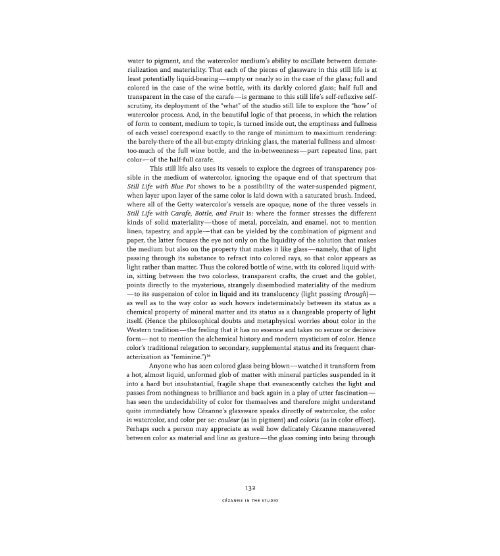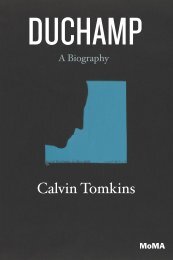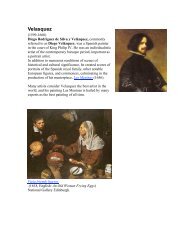Still Life in Watercolors
qbj8dgc
qbj8dgc
- No tags were found...
Create successful ePaper yourself
Turn your PDF publications into a flip-book with our unique Google optimized e-Paper software.
water to pigment, and the watercolor medium's ability to oscillate between dematerialization<br />
and materiality. That each of the pieces of glassware <strong>in</strong> this still life is at<br />
least potentially liquid-bear<strong>in</strong>g—empty or nearly so <strong>in</strong> the case of the glass; full and<br />
colored <strong>in</strong> the case of the w<strong>in</strong>e bottle, with its darkly colored glass; half full and<br />
transparent <strong>in</strong> the case of the carafe—is germane to this still life's self-reflexive selfscrut<strong>in</strong>y,<br />
its deployment of the "what" of the studio still life to explore the "how" of<br />
watercolor process. And, <strong>in</strong> the beautiful logic of that process, <strong>in</strong> which the relation<br />
of form to content, medium to topic, is turned <strong>in</strong>side out, the empt<strong>in</strong>ess and fullness<br />
of each vessel correspond exactly to the range of m<strong>in</strong>imum to maximum render<strong>in</strong>g:<br />
the barely-there of the all-but-empty dr<strong>in</strong>k<strong>in</strong>g glass, the material fullness and almosttoo-much<br />
of the full w<strong>in</strong>e bottle, and the <strong>in</strong>-betweenness—part repeated l<strong>in</strong>e, part<br />
color—of the half-full carafe.<br />
This still life also uses its vessels to explore the degrees of transparency possible<br />
<strong>in</strong> the medium of watercolor, ignor<strong>in</strong>g the opaque end of that spectrum that<br />
<strong>Still</strong> <strong>Life</strong> with Blue Pot shows to be a possibility of the water-suspended pigment,<br />
when layer upon layer of the same color is laid down with a saturated brush. Indeed,<br />
where all of the Getty watercolor's vessels are opaque, none of the three vessels <strong>in</strong><br />
<strong>Still</strong> <strong>Life</strong> with Carafe, Bottle, and Fruit is: where the former stresses the different<br />
k<strong>in</strong>ds of solid materiality—those of metal, porcela<strong>in</strong>, and enamel, not to mention<br />
l<strong>in</strong>en, tapestry, and apple—that can be yielded by the comb<strong>in</strong>ation of pigment and<br />
paper, the latter focuses the eye not only on the liquidity of the solution that makes<br />
the medium but also on the property that makes it like glass—namely, that of light<br />
pass<strong>in</strong>g through its substance to refract <strong>in</strong>to colored rays, so that color appears as<br />
light rather than matter. Thus the colored bottle of w<strong>in</strong>e, with its colored liquid with<strong>in</strong>,<br />
sitt<strong>in</strong>g between the two colorless, transparent crafts, the cruet and the goblet,<br />
po<strong>in</strong>ts directly to the mysterious, strangely disembodied materiality of the medium<br />
—to its suspension of color <strong>in</strong> liquid and its translucency (light pass<strong>in</strong>g through) —<br />
as well as to the way color as such hovers <strong>in</strong>determ<strong>in</strong>ately between its status as a<br />
chemical property of m<strong>in</strong>eral matter and its status as a changeable property of light<br />
itself. (Hence the philosophical doubts and metaphysical worries about color <strong>in</strong> the<br />
Western tradition—the feel<strong>in</strong>g that it has no essence and takes no secure or decisive<br />
form—not to mention the alchemical history and modern mysticism of color. Hence<br />
color's traditional relegation to secondary, supplemental status and its frequent characterization<br />
as "fem<strong>in</strong><strong>in</strong>e.") 16<br />
Anyone who has seen colored glass be<strong>in</strong>g blown—watched it transform from<br />
a hot, almost liquid, unformed glob of matter with m<strong>in</strong>eral particles suspended <strong>in</strong> it<br />
<strong>in</strong>to a hard but <strong>in</strong>substantial, fragile shape that evanescently catches the light and<br />
passes from noth<strong>in</strong>gness to brilliance and back aga<strong>in</strong> <strong>in</strong> a play of utter fasc<strong>in</strong>ation—<br />
has seen the undecidability of color for themselves and therefore might understand<br />
quite immediately how Cezanne's glassware speaks directly of watercolor, the color<br />
<strong>in</strong> watercolor, and color per se: couleur (as <strong>in</strong> pigment) and colons (as <strong>in</strong> color effect).<br />
Perhaps such a person may appreciate as well how delicately Cezanne maneuvered<br />
between color as material and l<strong>in</strong>e as gesture—the glass com<strong>in</strong>g <strong>in</strong>to be<strong>in</strong>g through<br />
132<br />
CEZANNE IN THE STUDIO




